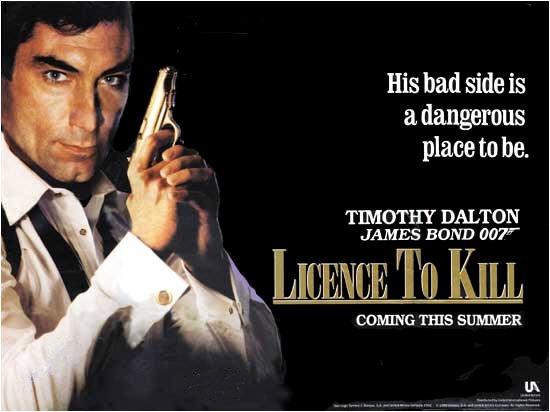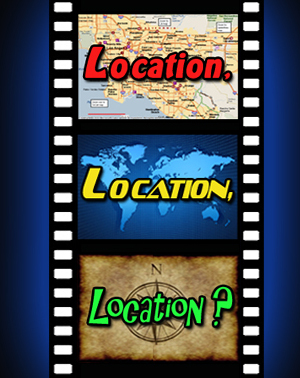
License to Kill is the best James Bond movie. By far. And it’s not even close. It’s not the most fun, to be sure, that’s completely subjective and not all that close either[i], but it brilliantly captures the essence of the literary character to the greatest degree, and that essence, boiled down to its most basic and fundamental nature, is that James Bond is a world-class jerk.
Consider how Bond treats women. Does he consider their hopes and dreams? One might argue, reasonably I suppose, that this is not the relationship that either party envisions when the door closes and clothes hit the floor, but it’s difficult not to wonder if the significantly less likely to survive half of the equation here would feel as charitably towards the event in question if the spectre of imminent death was presented to them at the moment of seduction. And what about his friends? Is their well-being being looked after or given proper reciprocal consideration? What about his performance in the work place? Is he a team player? Willing to listen to others?
When Timothy Dalton came back for a second turn at the wheel in License to Kill, whether realizing it or not, he delivered the defining film performance of the literary character, which was Bond at his very worst, and not surprisingly, at his absolute best.
It’s interesting to think about the character, since we’ve had well over thirty years of movies at this point, but it would seem to me the cinema-version James Bond has been lost and found so many times we often identify less with the attributes of Ian Fleming’s spy, or even with a particular film or era, than we do with the specific actor playing the title role. This is problematic in analyzing the franchise, since James Bond as a film character has worn so many hats we’re left with someone who functions less as a singular driving force and more as a series of archetypes. This is why people tend to discuss the series less from the nature of the character and more from the performance of the actor.
Now, every film geek[ii] has an opinion on which actor is the best Bond[iii] but this is the wrong perspective because every actor except for Lazenby played a different Bond, and not just from an interpretation of the character as a whole, but from movie to movie.
Consider Dr. No and Never Say never Again, two shockingly different movies stylistically, tonally and character-wise. To automatically say that Connery is the best Bond (the most commonly held opinion) is a mistake, because to argue that any actor is the best Bond obscures just how much the franchise and the vagaries of the different eras have dictated the personality of the film character, far more than any actor’s interpretation of the literary character.[iv]
So for me, the best Bond debate is best served by a movie-by-movie argument, not an actor debate[v], and while it’s fun to talk about the coolest villain, wildest chase sequence or goofiest gadget, it seems proper to focus attention on the central protagonist, especially since every James Bond movie opens with the actor’s name followed by ‘…in Ian Fleming’s insert movie title here’ or ‘as Ian Fleming’s James Bond’. But just who is the literary James Bond?
Fleming imagined a man who is functionally a sociopath. He is cruel, manipulative, vengeful, violent, single-minded of purpose and remorseless in action. He is cold. Ruthless. He is a snob with no sense of humor, served up with a side of sadism. James Bond is anything but huggable and this is the first flaw of the film franchise. A character who is cold, distant, brutal and vengeful is not ‘likable’ in any test-audience sort of way and the films fail (and in fairness also succeed) so often because they dip their toe in the water but ultimately reject the full force of Fleming’s Bond and instead play (mostly) as a series of vignettes with quippy lines and knowing smirks.
License to Kill has no such schizophrenic perspective. It’s a full-on revenge movie. Bond seeks it out, he executes his plan regardless of the consequences to himself and those friendly to his person and/or cause. There are no constraints attached to Bond’s motives or actions, and laid bare, they both become distressingly, violently single minded.
Consider what happens in the beginning of the film to spark his rampage of vengeance. His friend Felix’s wife, who Bond slept with, is murdered and Felix has his leg eaten by a shark, which, make no mistake about it, is not cool. Felix doesn’t set off for revenge, though, and it’s less that he physically isn’t able, but more you get the sense that it wouldn’t even occur to him to try. Bond has no such limitations and despite express orders to the contrary, starts killing his way through South America.
The movie works so well in part because it’s freed from the nonsense of the supervillain that bogs down so many of the Bond films. This allows the Bond character to function with a minimum of goofy seductions[vi] and a maximum of insanely sadistic executions. Here’s one that Bond carefully orchestrated AND THEN STUCK AROUND TO WATCH.
There was no reason for him to watch the man die, and you get the sense watching the clip that he’d be munching on popcorn all the while if the opportunity presented itself. Nothing could be gained from his presence, and in fact, only Bond’s discovery was possible. So our hero was willing to risk, and this is no exaggeration or descent into hyperbole, the single worst thing that could possibly happen to him in order to watch a man murdered in horrific fashion. Now we’re talking Fleming’s language.
Connery understood the literary character, though the movies sometimes let him down, and Daniel Craig made an admirable stab in the recent Casino Royale, but none of the actors have managed to match Timothy Dalton in License to Kill. It’s not necessarily because Dalton was the best Bond[vii], but rather that License to Kill forced the character to be who Fleming always imagined. The franchise often functions like a cage, and License to Kill is that beautiful moment when the bird shakes free from its shackles and flies free. And then goes on to directly and indirectly kill an ungodly number of people in brutalizing fashion.
You want silly escapism, and there are many days when I do, by all means sit down to Roger Moore and Pierce Brosnan. Summer blockbuster stupidity? Skyfall is right there waiting for you. But if you want Ian Fleming’s version of the character, your choices come down to Timothy Dalton in his second, last, and all too brief time as James Bond.
[i] The most fun is completely subjective, obviously, but my vote goes to The Living Daylights or Goldfinger.
[ii] Like myself, for instance, or that guy who owns all the Step Up movies and argues with energy and enthusiasm that Step Up 2: The Streets is the purest cinematic expression of geek chic since Donald kicked ass in Singing in the Rain. Also me, by the way.
[iii] It’s Dalton.
[iv] It’s Dalton, just as a fyi.
[v] It’s Dalton, though, just to be perfectly clear. He was the best Bond.
[vi] The attitude often seems to be, “Oh, that irascible Bond, there he goes chasing skirts again.” This presents the character as some sort of ladies’ man. But he’s not. He’s a killer in the best of times. And in License to Kill, he’s a murderer.
[vii] Dalton was the best Bond. In case there’s been a misunderstanding up until now.

 August 4th, 2013
August 4th, 2013  Geoffrey Geib
Geoffrey Geib  Posted in
Posted in  Tags:
Tags: 






